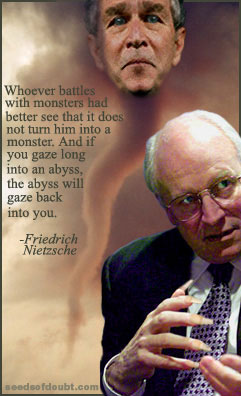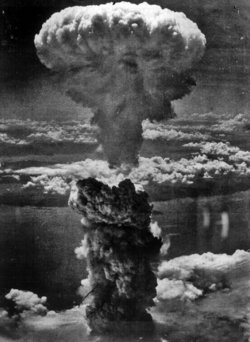By Peter Dale Scott, Pacific News Service
Posted on January 5, 2006, Printed on January 12, 2006
http://www.alternet.org/story/30434/
Revelations that the National Security Agency (NSA) has engaged in warrantless eavesdropping in violation of the Foreign Intelligence Surveillance Act prompted President Bush to admit last month that in 2002 he directly authorized the activity in the wake of 9/11.
But there are reasons to suspect that the illegal eavesdropping, and the related program of illegal detentions of U.S. citizens as well as foreign nationals, began earlier. Both may be part of what Vice President Dick Cheney has called the Bush administration's restoration of "the legitimate authority of the presidency" -- practices exercised by Nixon that were outlawed after Watergate.
In the 1980s Richard Cheney and Donald Rumsfeld discussed just such emergency surveillance and detention powers in a super-secret program that planned for what was euphemistically called "Continuity of Government" (COG) in the event of a nuclear disaster.
At the time, Cheney was a Wyoming congressman, while Rumsfeld, who had been defense secretary under President Ford, was a businessman and CEO of the drug company G.D. Searle. Overall responsibility for the program had been assigned to Vice President George H.W. Bush, "with Lt. Col. Oliver North...as the National Security Council action officer," according to James Bamford in his book, "A Pretext for War."
These men planned for suspension of the Constitution, not just after nuclear attack, but for any "national security emergency," which they defined in Executive Order 12656 of 1988 as: "Any occurrence, including natural disaster, military attack, technological or other emergency, that seriously degrades or seriously threatens the national security of the United States." Clearly 9/11 would meet this definition.
As developed in the mid-1980s by Oliver North in the White House, the plans called for not just the surveillance but the potential detention of large numbers of American citizens. During the Iran-Contra hearings, North was asked about his work on "a contingency plan in the event of emergency, that would suspend the American constitution." The chairman, Democratic Senator Inouye, ruled that this was a "highly sensitive and classified" matter, not to be dealt with in an open hearing.
The supporting agency for the planning and implementation was the Federal Emergency Management Agency (FEMA). FEMA was headed for much of the 1980s by Louis Giuffrida, whose COG plans for massive detention became so extreme that even President Reagan's then Attorney General, William French Smith, raised objections.
Smith eventually left Washington, while COG continued to evolve. And in May 2001 Cheney and FEMA were reunited: President George W. Bush appointed Cheney to head a terrorism task force and created a new office within FEMA to assist him. In effect, Bush was authorizing a resumption of the kind of planning that Cheney and FEMA had conducted under the heading of COG.
Press accounts at the time claimed that the Cheney terrorism task force accomplished little and that Cheney himself spent the entire month of August in a remote location in Wyoming. But this may have just been the appearance of withdrawal; as author James Mann points out in "The Rise of the Vulcans: The History of Bush's War Cabinet," Cheney had regularly gone off to undisclosed locations in the 1980s as part of his secret COG planning.
As to the actual role of Bush, Cheney and FEMA on 9/11 itself, much remains unclear. But all sources agree that a central order at 10 a.m. from Bush to Cheney contained three provisions, of which the most important was, according to the 9/11 Commission Report, "the implementation of continuity of government measures."
The measures called for the immediate evacuation of key personnel from Washington. Both Cheney and Rumsfeld refused to leave, but Deputy Defense Secretary Paul Wolfowitz was helicoptered to a bunker headquarters inside a mountain. Cheney also ordered key congressional personnel, including House Speaker Dennis Hastert, to be flown out of Washington, along with several cabinet members.
During Cheney's later disappearance from public view for a long period after the attack, he too was working from a COG base -- "Site R," the so-called "Underground Pentagon" on the Maryland-Pennsylvania border, according to Bamford.
Many actions of the Bush presidency resemble not only what Nixon did in the 1970s, but what Cheney and Rumsfeld had planned to restore under COG in the 1980s in the case of an attack. Prominent among these have been the detention of so-called "enemy combatants," including U.S. citizens, and placing them in special camps. Now as before, a policy of detentions outside the Constitution has been accompanied by a program of extra-constitutional surveillance to determine who will be detained.
As Cheney told reporters on his return last month from Pakistan, "Watergate and a lot of things around Watergate and Vietnam, both during the '70s served, I think, to erode the authority" of the president. But he defended as necessary for national security the aggressive program he helped shape under President George W. Bush, which includes warrantless surveillance and extrajudicial imprisonment -- in effect, a new Imperial Presidency.
At least two Democrats in Congress have suggested that Bush could be impeached for his illegal surveillance activities. The chances of impeachment may depend on whether Congress can prove that planning for this, like planning for the Iraq War, began well before 9/11.
Peter Dale Scott is author of "Drugs, Oil, and War: The United States in Afghanistan, Colombia, and Indochina" (Rowman & Littlefield, 2003) and is completing a book on "Deep Politics and the Road to 9/11."







No comments:
Post a Comment